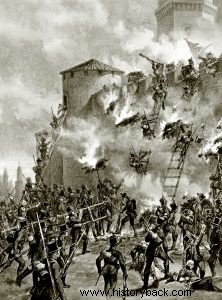
After the decision of the Tsar Paul of Russia to annex Georgia, in 1800, his successor Alexander I followed this expansionist policy in the Caucasus. His goal was to overthrow the various Muslim states in the region that were supported by Persia.
One of these states was the Khanate of Ganja. The governor of the state, Javad Khan, defied the Russians. His state was founded in 1747 centered on Ganja in today's northwest Azerbaijan. General Pavel Chistianov, head of a small division-sized force, undertook to clear the "abscess".
Chistianov had only six infantry battalions (1 grenadier, two musketeers and three hunters), a regiment of dragoons (three isles), two isles of Cossacks (165 men), 700 Tatar light cavalry and 12 guns. The city's garrison consisted of 1,700 soldiers with four guns. However, most of the inhabitants also took part in the impending battle.
On November 10, 1803, the Russian force arrived outside the city. The Russian general asked Javad Khan to surrender. But the latter refused. After this the Russians started the siege. It was a difficult operation in the heart of winter.
Finally Chistianov seeing the siege drag on and fearing the arrival of reinforcements decided to attack. The attack was set for January 3, 1804. Chistianov divided his forces into two phalanxes. One under Major General Portniagin would attack the Karabakh gate and the other, under Colonel Karyagin would attack the Tbilisi gate.
Unstoppable Russian raid
Early in the morning of January 3, Portnyagin's phalanx approached the Karabakh gate. The Russian lieutenant general's men charged against the walls with the help of ladders. Twice the Russians attacked and twice they were repulsed. After that Portniagin put himself at the head of his men with sword in hand and climbed the wall. He was followed by a lieutenant who, however, was cut down by enemy fire.
This was followed by Major Bartenev who was also killed. The Russian grenadiers immediately arrived and regardless of the losses they managed to climb the wall helping the lieutenant general who was desperately fighting alone.
At the same time the phalanx of Karyagin also managed to climb the wall and capture a tower at the gate of Tbilisi. His hunters captured two other towers after a fierce battle with bayonets. Javad Khan was fighting there desperately. Captain Kalovski approached him . The Russian managed a good hit on the Muslim leader leaving him dead.
Javad's guards attacked with fury and fanaticism and literally cut the brave Russian officer to pieces. Nevertheless, the loss of Javad was a turning point for the defenders. Soon the defense collapsed and panic set in. Armed men and civilians were running indiscriminately in the streets with Russian soldiers "clearing" the field with bayonets.
The defenders put up their last resistance at the Juma Mosque where 500 of them had fortified themselves. They were all slaughtered as most of them were from Dagestan and there was deep hatred between them and the Russians.
According to Iranian sources, the massacre in the city lasted for three days and resulted in the death of a total of 10,000 people of all ages and sexes. Russian sources put the number down to 3,000. In the conflict, Javad's eldest son was also killed while the rest of his family was captured.
Chistianov formally and publicly thanked his men for their great and indeed difficult victory achieved thanks to their high morale and devotion to duty.
It is worth noting that Javad had requested help from the Shah of Iran who sent a force of 30,000 men to lift the siege. However, the Persians did not manage to arrive because of the winter.

The raid of the Russian hunters.

Russian general Pavel Chistianov.
